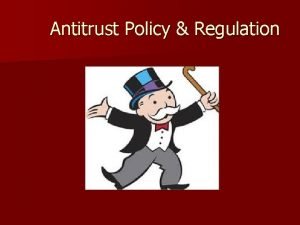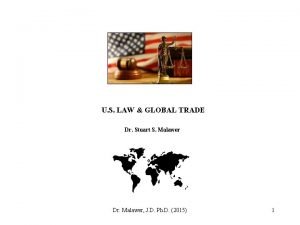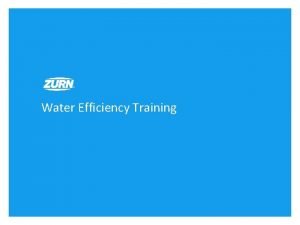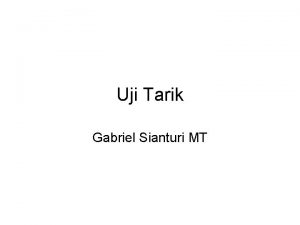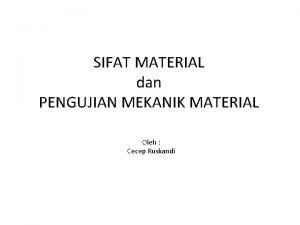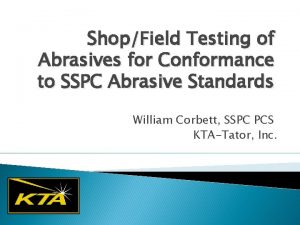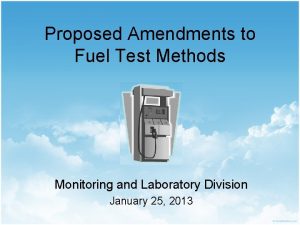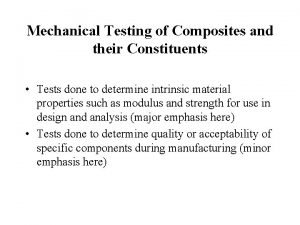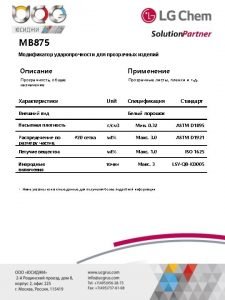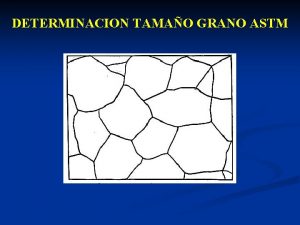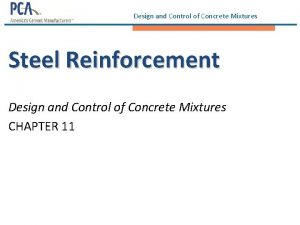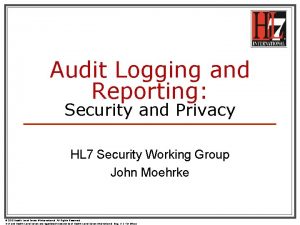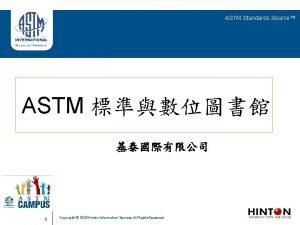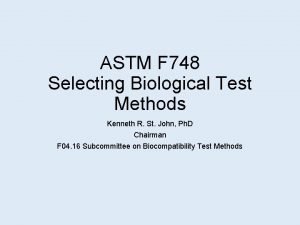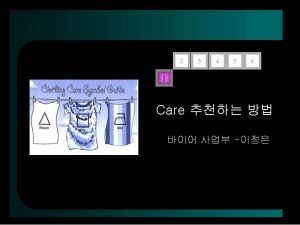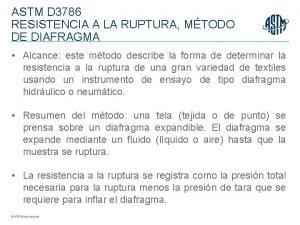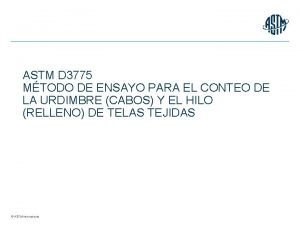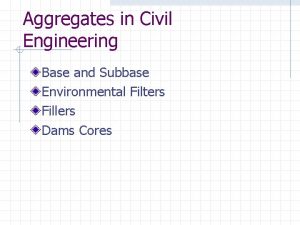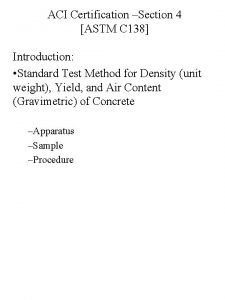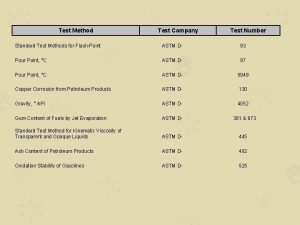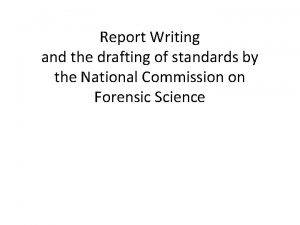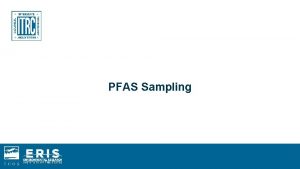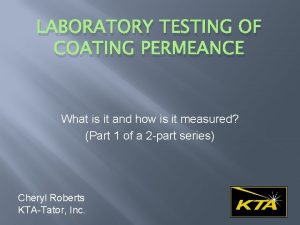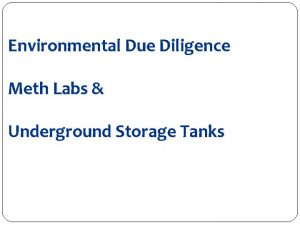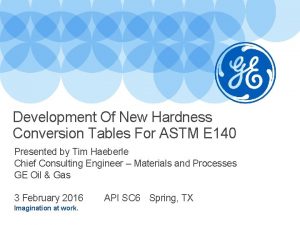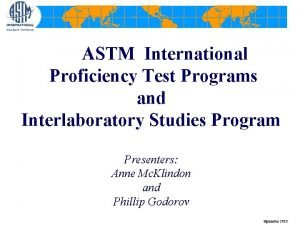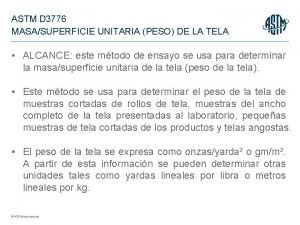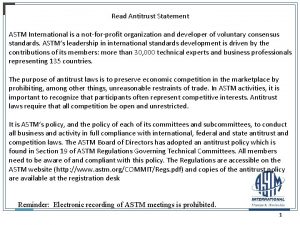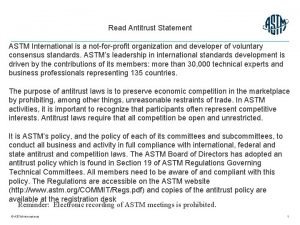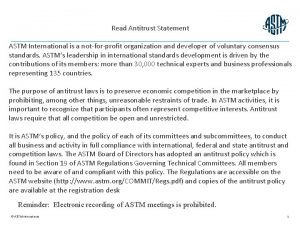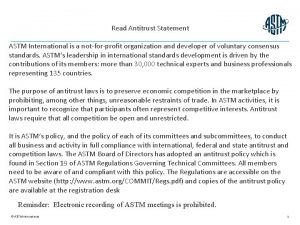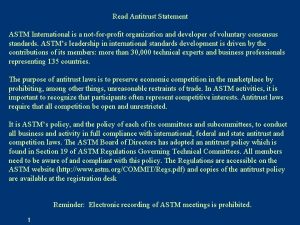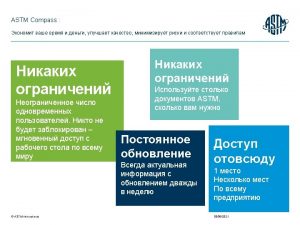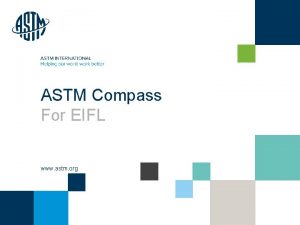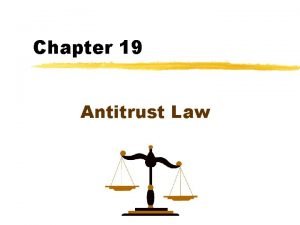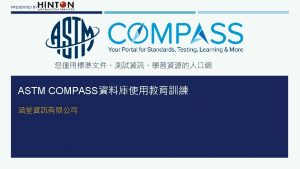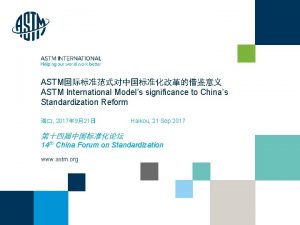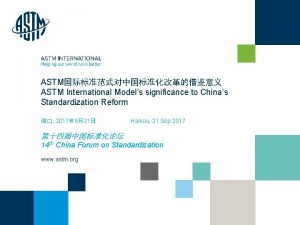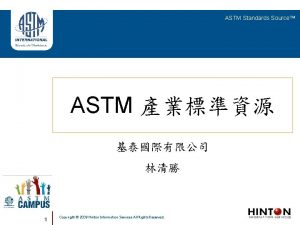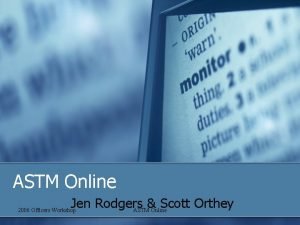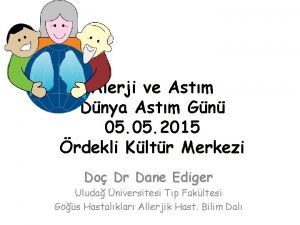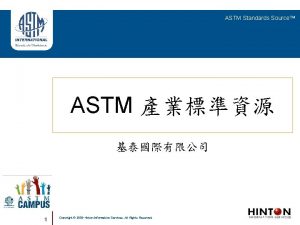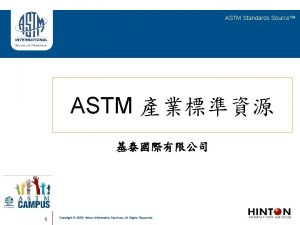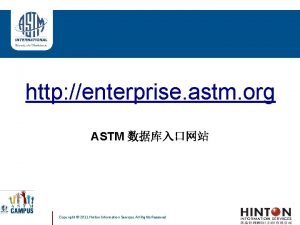Read Antitrust Statement ASTM International is a notforprofit


































- Slides: 34

Read Antitrust Statement ASTM International is a not-for-profit organization and developer of voluntary consensus standards. ASTM’s leadership in international standards development is driven by the contributions of its members: more than 30, 000 technical experts and business professionals representing 135 countries. The purpose of antitrust laws is to preserve economic competition in the marketplace by prohibiting, among other things, unreasonable restraints of trade. In ASTM activities, it is important to recognize that participants often represent competitive interests. Antitrust laws require that all competition be open and unrestricted. It is ASTM’s policy, and the policy of each of its committees and subcommittees, to conduct all business and activity in full compliance with international, federal and state antitrust and competition laws. The ASTM Board of Directors has adopted an antitrust policy which is found in Section 19 of ASTM Regulations Governing Technical Committees. All members need to be aware of and compliant with this policy. The Regulations are accessible on the ASTM website (http: //www. astm. org/COMMIT/Regs. pdf) and copies of the antitrust policy are available at the registration desk Reminder: Electronic recording of ASTM meetings is prohibited. © ASTM International 1

Committee D 02 on Petroleum Products, Liquid Fuels and Lubricants Member Orientation Jim Simnick, Vice Chairman www. astm. org © ASTM International

Helping Our World Work Better 12, 000+ ASTM standards operate globally © ASTM International Applied to just about everything from steel to sustainability They improve the lives of millions every day 3

ASTM By the Numbers 30, 000+ 90 global ASTM members in over 148 countries participating in ASTM 52 proficiency testing programs involve 4, 700 Laboratories and 6, 500 units of participation 58% of participation from outside USA © ASTM International industry sectors represented and 80% of world commodity trade affected by standards 145 main committees 2, 017 subcommittees 95 1, 500 memorandums of understanding people trained annually across 145 ASTM courses 6, 788 ASTM standards have been adopted, used as a reference, or used as the basis of national standards outside the USA 27, 632 symposia papers and chapters, with 15, 341 journal papers accessible through Compass® 4

ASTM INTERNATIONAL © ASTM International 5

Training from the Experts Training Hands-on and practical, ASTM training programs help users get the most out of standards They’re informed, relevant and built on sectorspecific expertise D 02 Training Courses: ASTM D 3241 Heater Tube Rating Workshop 1, 500 people trained annually across 100 ASTM courses ASTM Petroleum Lab Technician Online Training Aviation Fuels: Specifications and Test Methods Crude Oil: Sampling, Testing, and Evaluation Diesel Fuel: Specifications and Test Methods Gasoline: Specifications, Testing, and Technology Marine Fuels: Specifications, Testing, Purchase, and Use Statistics in ASTM Standard Test Method Development, Application, and Quality Assurance © ASTM International 6

Independent and Objective Testing and Certification Proficiency Testing Services: confirm and improve competence; determine method accuracy; instill the ability to judge, assess and compare test methods 52 proficiency testing programs involve 4, 700 Laboratories and 6, 500 units of participation 58% of participation from outside USA Resulting data creates statistical summary reports Certification and Declaration Programs provide independent evaluation of compliance to standards or regulations Available worldwide, they provide a level playing field, answer regulatory needs and reinforce consumer confidence ASTM also offers Personnel Certification Programs D 02 Programs: Octane Testing Diesel Exhaust Fluid Testing Petroleum Products & Lubricants © ASTM International 7

Member Opportunities § § § Vote on Ballots Attend meetings Contribute to Methodology Participate in Precision Studies Participate as a leader in the development process Access to Website § § Rosters, agendas, minutes Subcommittee Membership § © ASTM International ASTM membership is required 8

Organization and Personal Benefits § Surveillance of Method Development § Informal Exchange of Ideas § Develop & Demonstrate: Leadership, Technical, Organizational, Presentation, Negotiating Skills § Enhance Knowledge of Technical Issues § Exposure to New Techniques § Permits Comparison of Results § Customer Interaction § Enhance Image § Participate in Development of International Standards § Training and Improvement § Establish a Global Network § Consistent Application of Testing § Make New Friends © ASTM International 9

ASTM Standardization Concepts © ASTM International 10

What is a Standard? As defined by ASTM § A Document developed and established; § Using consensus principles § meets the requirements of ASTM procedures and regulations. § Developed with participation of all stakeholders § ASTM uses term “standard” as adjective to describe following types of standards: § Specifications § § § © ASTM International Test Methods Practices Guides Classifications Terminology 11

Introduction to ASTM Committee D 02 on Petroleum Products, Liquid Fuels, and Lubricants © ASTM International 12

Committee D 02 n Largest ASTM Committee, organized in 1904 n Includes over 2, 400 members from more than 65 countries n Developer of over 800 petroleum standards that have helped to provide heat for homes, fuel for automobiles and airplanes, and lubricants for machinery n Sponsor of numerous technical publications, laboratory quality assurance programs and technical and professional training courses, workshops, and symposia. © ASTM International 13

Committee D 02 Scope Liquid fuels derived from: petroleum or the liquefaction of coal, shale, oil sands, or other naturally occurring materials including: Liquid fuels, . . Liquid and semi-solid lubricants. . Liquid fuels derived from biological materials (biofuels) Synthesized liquid fuels (also known as renewable or alternative fuels) Hydraulic fluids. . Petroleum Coke. . Gaseous fuels. . Waxes. . © ASTM International 14

D 02 Committee Structure MAIN Committee D 02 on Petroleum Products, Liquid Fuels, and Lubricants Subcommittee. 03 Elemental Analysis Subcommittee. 08 Volatility Sections / Task Groups … 15 Subcommittee. J Aviation Fuels Many subcommittees and sections / task groups Subcommittee. 90 Executive Subcommittee. 94 Quality Assurance and Statistics Sections / Task Groups …

Executive Subcommittee § Membership § All Subcommittee Chairmen & Committee Officers § At Large Members, minimum 6 § Responsibilities § SC Formation & dissolution § SC Scopes & objectives § Appoint Subcommittee Officers § Reviews Main committee membership § Committee bylaws & long range planning § Awards panel © ASTM International 16

Product Subcommittees . A . B . C . D . E . F . G . H . J . L . N . P 12 Product subcommittees • Specifications Gasoline and Oxygenated Fuels Automotive Lubricants • Performance Testing Turbine Fuels Hydrocarbons for Chemical and Special Uses Burner, Diesel, Non-Aviation Gas Turbine and Marine Fuels Manufactured Carbon and Graphite Products Lubricating Greases Liquefied Petroleum Gases Aviation Fuels Industrial Lubricants Hydraulic Fluids Recycled Products © ASTM International 17

Properties Subcommittees . 01. 02. 03. 04. 05. 06. 07. 08. 09. 10. 12. 14. 25 Combustion Characteristics Hydrocarbon Measurement for Custody Transfer (Joint ASTM/API) Elemental Analysis Hydrocarbon Analysis Properties of Fuels, Petroleum Coke and Carbon Materials Analysis of Lubricants Flow Properties Volatility Oxidation of Lubricants Properties of Petroleum Wax Environmental Standards for Lubricants Stability and Cleanliness of Liquid Fuels Performance Assessment and Validation of Process Stream Analyzer Systems 13 Properties Subcommittees • Test Methods for Properties and Measurements © ASTM International 18

Coordinating Subcommittees . 91 Thermometry. 92 Interlaboratory Crosscheck Programs. 93. 94. 95. 96 International Standards and Related Activities Quality Assurance and Statistics Terminology In-Service Lubricant Testing and Condition Monitoring Services 6 Coordinating Subcommittees © ASTM International 19

Participation and Membership Committees and Subcommittees © ASTM International

The ASTM Process Documents are drafted and revised in the task group New standards are required to be balloted at the subcommittee level at least once After subcommittee approval, the main committee & entire Society Detailed procedures included in Regulations Governing ASTM Technical Committees Committee on Standards © ASTM International Society and Main Committee Subcommittee Task Group 21

What are the steps in the ASTM Process? Contact ASTM • Determine need & stakeholder commitment for proposed standard Main/ Concurrent Ballot • Open 30 days Register Work Item • Approval by sub chair or at a meeting Approval • Editorial review Draft Standard • Task group formed and develop draft Subcommittee Ballot • Open 30 days • Address negatives, if any Publication • Within 6 weeks of approval • Address negatives, if any © ASTM International 22

Where the Work Gets Done! Technical Subcommittees § Subcommittee Sections § Usually a long standing working group dealing with a topical area with in the SC scope § Technical Panels § Working group with specific STM support responsibility § Work Group, Task Group, Study Group § Small working group who develop, write, conduct precision studies on new or current methods, specifications, etc. § These working groups may report to another work group, to a SC, or to the Committee, depending who created Naming conventions are SC dependent © ASTM International 23

D 02 Work Groups and Task Groups Fundamental Operating Unit of the Committee Ad hoc or Informal Group Develops an Idea or Executes a Specific Charge Generate a Work Item number Hold Task Group meetings At Committee Weeks or between meetings Present and Discuss at Section level, if appropriate Recommend actions to Subcommittee Level Open Participation! © ASTM International 24

Work Group Membership Anyone interested in the task is encouraged to participate ASTM membership is not required, but preferred Writes Standard, or conducts a special project Review, Revise, or update a current standard Prepare a recommendation for a Subcommittee Conducts Interlaboratory study, if appropriate Writes research report if appropriate Research reports are required to support a change in precision © ASTM International 25

Parliamentary Procedure Robert’s Rules of Order Structure and Order to Meetings Helps protect Member rights and privileges General Meeting Structure Call to Order Approval of Minutes and Agendas Officer and Task Reports Old Business New Business Adjournment © ASTM International 26

Membership Classification and Voting © ASTM International

What are the steps in the Membership Classification Process? Contact ASTM • ASTM Website • Call Customer Service • Attend an ASTM Meeting • Submit to ASTM for processing Review by Officers • Receive email notice of new member application A Review and Approval by D 02. 90 • Executive majority approval required for all assignments. © ASTM International Classification Voting Rights Assignment Membership Secretary(s) Review Complete Membership Application • Pending applications are compared to existing Roster and Scope of Organization. Option for Appeal for Review • Any member can request the Executive to review and consider additional information. 28

Importance of the Official Voter Distinction Creates a Valid Ballot 60% ballot return of official voters. 67% (two-thirds) affirmative official votes at the subcommittee level 90% affirmative official votes at the main committee level. ASTM Regulations Sections 11. 2. 1 and 12. 2. 1 Official Voter Distinction is used to Resolve Negatives Actions as: Not Persuasive or Not Related or Previously Considered 67% (two-thirds) affirmative official votes at the subcommittee level ASTM Regulations Section 11. 4. 3. 3 67% (two-thirds) affirmative official votes at the main committee level. ASTM Regulations Section 12. 4. 2. 1 © ASTM International 29

Balance of Interest ASTM Producer User & General Interest Classified Technical Committees are balanced. No excess influence by any interest group © ASTM International 30

VOTING ASTM regulations Defines Voting Privileges as Section 6. 2 Voting Privileges—Every ASTM member is entitled to vote on all Society Review items as well as on each ballot of a main committee and subcommittee to which the member belongs. All negatives and comments received from all ballot returns, including those from non-official voting members, shall be considered in accordance with these regulations. • All members may vote on All ballots negative votes/comments are considered Caution! - Failure to return 3 consecutive ballots at the same level may result in a loss of vote © ASTM International 31

ASTM Staff Contacts Alyson Fick Manager, Technical Committee Operations afick@astm. org / 610 -832 -9710 Len Morrissey Director, Technical Committee Operations lmorrissey@astm. org / 610 -832 -9719 Lisa Drennen Administrative Asst. , Technical Committee Operations ldrennen@astm. org / 610 -832 -9735 Jessica Barrett D 02 Editor, Technical Committee Operations jbarrett@astm. org / 610 -832 -9655 © ASTM International 32

WHAT IS “ASTM”? An honored entity with constant progression, Specifications are the keys to its recognition, Test Methods that cater to umpteen industries, Mirror its importance in all of the countries! In a world that needs order and standardizations, Here’s ASTM … with its respected solutions! Imran Hussami – D 02 Member © ASTM International July 6, 2012 33

Questions? www. astm. org © ASTM International 34
 Oil spill
Oil spill Antitrust laws
Antitrust laws Antitrust laws
Antitrust laws Astm d6284
Astm d6284 Standar spesimen uji tarik astm e8
Standar spesimen uji tarik astm e8 Spt hammer calibration
Spt hammer calibration Sifat material
Sifat material Vial test for abrasives
Vial test for abrasives Astm d7754
Astm d7754 Rock solid precast
Rock solid precast Mechanical testing of composites
Mechanical testing of composites Astm d1921
Astm d1921 Diagram plastisitas casagrande
Diagram plastisitas casagrande X-cut astm d6677
X-cut astm d6677 Astm5470
Astm5470 Aatcc 172
Aatcc 172 Tamaño de grano astm tabla
Tamaño de grano astm tabla Fracture control
Fracture control Astm e2147-18
Astm e2147-18 Astm d1068
Astm d1068 Astm f748
Astm f748 Astm care symbols
Astm care symbols Astm d 3786
Astm d 3786 Astm d 3775
Astm d 3775 Astm c33 sand gradation
Astm c33 sand gradation Astm 138
Astm 138 Astm d3682
Astm d3682 Astm e620
Astm e620 Astm d 7968
Astm d 7968 Water vapour transmission astm1653
Water vapour transmission astm1653 Astm e1528 14 transaction screen questionnaire
Astm e1528 14 transaction screen questionnaire Astm hardness conversion
Astm hardness conversion Astm proficiency testing
Astm proficiency testing Astm committee week 2021
Astm committee week 2021 Astm d 3776
Astm d 3776
